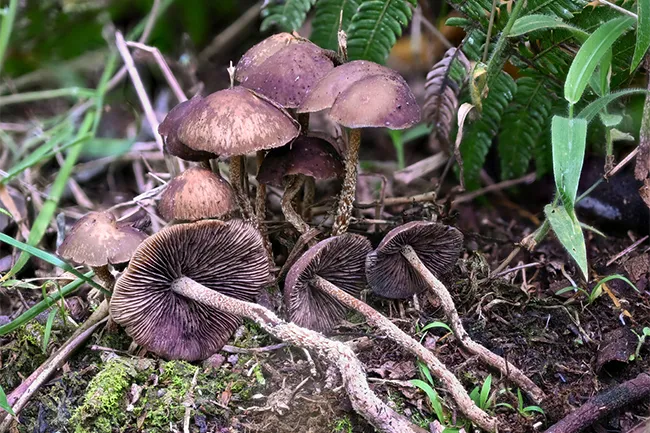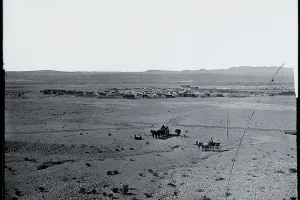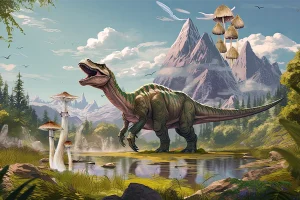Psilocybe zapotecorum was first described in scientific literature by French botanist Roger Heim and Banker-turned-mycologist Robert Gordon Wasson in Mexico in 1956—likely during one of the Wasson’s CIA shadow-funded field trips. R. Gordon Wasson and Valentina Pavlovna Wasson are largely credited with popularizing “magic mushrooms” in Western culture. But the history of psilocybin mushrooms begins long before the Wasson’s mycological excursions.
The couple was given psilocybin mushrooms for the first time by María Sabina, a Mazatec sabia. Sabina spoke only Mazatec, but recordings of her songs and life story were translated into English in 2003, with writing from Álvaro Estrada and editing by Jerome Rothenberg.1 In translation, Sabina explains that she first ate the mushrooms as a child: She had witnessed a vigil with the “saint children” led by a Wise Man named Juan Miguel.2,3 She met the Wassons in the 1950s, introduced by a town official, Cayetano Gárcia. Gárcia promised R. Gordon that Sabina would give Gordon the mushrooms, and Sabina did as the authority requested.4 R. Gordon subsequently wrote about what he learned from Sabina in an article for LIFE Magazine in 1957, with Valentina publishing her own article on the mushrooms Sabina had given her in This Week shortly afterward.
Deeper Learning
In the decades that followed R. Gordon Wasson’s article, tourists began to visit Sabina and the remote Mazatec community she was a part of. The project Historias y Memorias Mazatecas works to preserve Mazatec history and is currently looking for support.
The Psilocybe zapotecorum species is one of many psilocybin mushroom species that grows naturally in Mexico. The name “zapotecorum” was given in honor of the Zapotec community, Indigenous to the region where Heim and Wasson picked the mushrooms. To date, the harms of the appropriation of Indigenous plant medicines—and fungi—is something nonprofits like the Indigenous Medicine Conservation Fund and the Indigenous Reciprocity Initiative of the Americas hope to address.
Habitat and Ecology of P. zapotecorum
The original descriptions of P. zapotecorum described this mushroom as growing in swampy, muddy soils, but the species actually has a much wider habitat preference. The mushrooms prefer moist habitats. Still, they’ve been frequently found growing out the sides of ravines and where landslides have occurred. They’re known to inhabit woody debris found in damp high altitude cloud forests between 900 and 3500m, as well as in flat subtropical forests closer to sea level. Records show P. zapotecorum mushrooms seem to grow mostly in southern Mexico and Guatemala. They’ve also been spotted in other South American countries, including Colombia, Brazil, Ecuador, Argentina, Venezuela and Peru.

How to Identify the Psilocybe zapotecorum
Historically, P. zapotecorum has not always been easily identified, resulting in a few nomenclatural mix-ups in the published literature. Famous Mexican mycologist and specialist of the genus Psilocybe Guzmán (1932-2016) published a revised description of P. zapotecorum in 2012, and identified 12 different scientific latin names given to this species in error, in the decades since its original documentation.
P. zapotecorum Color
The cap of P. zapotecorum can range widely in color from a pale yellow, through orange to reddish or dark brown. The stem can be a similar color to the cap, but is sometimes lighter, appearing more white in certain specimens. The gills of this mushroom can be whitish to pale reddish-brown, or may appear more purple-brown as spores begin to form on them.

P. zapotecorum Cap
The cap of this mushroom is typically around 1 ½ to 2 ¾ inches (4-7 cm) wide, but can grow to around 4 ⅓ inches (11 cm) in the largest specimens. The shape of the cap can vary considerably, from almost flat (convex-plane) through to rounded (convex), cone- or bell-shaped. Even more confusingly the center of the cap can sometimes either have a nipple in the center (papillate), or a small depression (subumbilicate).
How to Grow Shrooms Bundle
Take Both of Our Courses and Save $90!
The gills of P. zapotecorum attach to the stipe concavely (sinuate) or narrowly (adnexed). A thin weblike veil covers the gills in younger mushrooms that break away as the cap opens. Sometimes the veil remnants remain as fluffy scales on the edge of the cap, or as a light ring around the stem, though both can fall away by rain, wind or rough handling.
P. zapotecorum Stem
The stem of wild P. zapotecorum is around 4-7 inches (10-18 cm), though cultivated specimens have been recorded at an impressive 13 inches (33 cm). The stems can be solid or hollow, and are typically covered in fluffy white scales. The base of the stem is usually connected to a long root-like structure called a pseudorhiza, which is made of one or more thick cords of mycelium buried under the surface of the substrate.
Before Wasson, I felt the saint children elevated me. I don’t feel like that anymore. The force has diminished. If Cayetano hadn’t brought the foreigners… the saint children would have kept their power.
—Maria Sabina, from Maria Sabina: Her Life and Chants.5,6
P. zapotecorum Spores
Like almost all species in the genus Psilocybe, the spores of P. zapotecorum leave a purplish, dark brown spore print.
Psilocybe zapotecorum Potency
Psilocybin and psilocin were first measured in P. zapotecorum by Roger Heim and Albert Hofmann in the late 50s, who found it to contain only 0.05% psilocybin and no psilocin. However the original study, written in French, admitted that the two year old dried mushroom sample they analyzed was very likely to be unrepresentative of the species’ real potency. Only three additional modern-day studies have tested this mushroom’s potency after Heim and Hofmann’s first tests.

In 1993, an unlikely collaboration between Nestle’s Research Centre in Switzerland and a Brazilian biodiversity conservation organization published a survey of psychoactive mushrooms from the state of Paraná, Brazil. In it, samples of dried P. zapotecorum were recorded to contain 0.06-0.3% psilocybin and 0.05-0.1% psilocin. Baeocystin—another compound that may influence the psychoactive effects of the mushroom— was also recorded at a maximum concentration of 0.02%.
A paper published in 2022 by Klára Gotvaldová and colleagues analyzed the potency of 82 collections of mushrooms, including two fruiting bodies of wild P. zapotecorum collected from Mexico in 2016. This study found concentrations of and 0.90-0.97% psilocybin and 0.029-0.037% psilocin, as well as baeocystin (0.043-0.048%) norbaeocystin (around 0.021%) and aeruginascin (0.021%)
The most surprising potency results came from a 2023 interdisciplinary study of P. zapotecorum, conducted by Ohio State and Vanderbilt Universities in partnership with The Entheome Foundation and Tryp Labs. By growing a wild-isolated strain of P. zapotecorum “La Martinica” under laboratory conditions, the researchers recorded an average potency of 1.79% psilocybin from whole mushrooms, and a maximum potency of 3.04% in the caps.
Until this research, the strongest recorded psilocybin potency in the scientific literature was from an Oregon-collected sample of Psilocybe azurescens, with a potency of 1.78% psilocybin. This new study suggested that some strains of P. zapotecorum might be the strongest psilocybin-containing mushrooms known to science. Despite this, the authors of the paper acknowledge that better handling procedures used in their study may have resulted in less psilocybin breakdown during the experiment, leading to a “truer” representative potency measurement. Also it is worth noting that all studies of P. zapotecorum potency conducted before 2023 measured the alkaloid content of wild species. It could also be that the controlled, nutrient-rich conditions under which the La Martinica strain was grown allowed it to produce more psilocybin than its wild cousins.
P. zapotecorum Cultivation
Roger Heim was the first person to record their cultivation of P. zapotecorum in 1958. He reported struggling to get it to fruit on various substrates. Historically, this mushroom was rarely cultivated. But in recent years, there has been a resurgence in attempts to grow P. zapotecorum. Though some have been successful, many of these attempts resulted in poor growth or misshapen mushrooms that failed to produce spores.

One of the most successful grows was published in the 2023 study, using a simple coir vermiculite mix inoculated with whole oats. The incubation temperature was 68-72°F (20-22°C). The authors explained that a fine mist provided by an ultrasonic humidifier is preferable; direct misting caused the growing mushrooms to die back. In addition, the cultivators claimed that low light levels and a simple casing layer were crucial in getting a good yield of healthy mushrooms that resembled their wild parents. The mushrooms took around 3-5 months to cultivate.
Some growers prefer to harvest cultivated P. zapotecorum with scissors, due to the root-like pseudorhiza typical of this species. They cut away the thick mycelial cord to prevent too much disturbance to the substrate.
A Final Question—Is Psilocybe zapotecorum Edible?
Psilocybe zapotecorum, like many other magic mushrooms, is edible but is favored more for its psychedelic, rather than culinary properties. A 2023 study of P. zapotecorum has described the mushroom as having a sour taste “similar to a 9v battery” and a “smell reminiscent of cucumber and radishes” which while certainly unique, might not be what some consider a particularly pleasant culinary experience.
Notes
- “My parents spoke only Mazatec. I ever learned another language.” (Rothenberg and Estrada, 15) ↩︎
- “They were the same mushrooms that the Wise Man Juan Miguel had eaten. I knew them well.” (Rothenberg and Estrada, 13) ↩︎
- “Some days” after the vigil with Juan Miguel, Sabina found mushrooms growing in a pasture while she was out with her sister and she ate them: “Without thinking too much about it, I put the mushrooms in my mouth and chewed them up.” (Rothenberg and Estrada, 13)
The mushrooms grow naturally in Sabina’s home region of Oaxaca, Mexico. Sabina’s grandparents also talked about the mushrooms with reverence: “I remember that my grandparents spoke of these mushrooms with great respect. That was why I knew they weren’t bad.” (Rothenberg and Estrada, 13)
As an adult, Sabina became a sabia—a Wise Woman—herself. She used the mushrooms to heal the sick in her community and as part of her communion with God: “Sometime later I knew that the mushrooms were like God. That they gave wisdom, that they cured illnesses, and that our people, since a long time ago, had eaten them. That they had power, that they were the blood of Christ.” (Rothenberg and Estrada, 14) ↩︎ - “Years later, when I became a widow for the second time, I gave myself up for always to wisdom in order to cure the sickness of people and to be myself always close to God. One should respect the little mushrooms. At bottom I feel they are my family. As if they were my parents, my blood. In truth I was born with my destiny. To be a Wise Woman. To be a daughter of the saint children. ” (Rothenberg and Estrada, 14) ↩︎
- “It’s true that Wasson and his friends were the first foreigners who came to our town in search of the saint children and that they didn’t take them because they suffered from any illness. Their reason was that they came to find God. Before Wasson nobody took the mushrooms only to find God. The little mushrooms were always taken for the sick to get well.” (Rothenberg and Estrada, 49) ↩︎
- In translation, Sabina has also said that she would have given the Wassons mushrooms even if she wasn’t asked by an authority: “It’s true that before Wasson nobody spoke so openly about the children. No Mazatec revealed what he knew about this matter. But I obeyed the síndico [town authority]; nevertheless, I think now that if the foreigners had arrived without any recommendation, I would still have shown them my wisdom, because there is nothing bad in that, the children are the blood of Christ.” (Rothenberg and Estrada, 57) ↩︎
References
Rothenberg, Jerome; Estrada, Álvaro (2003). Maria Sabina: Selections. University of California Press. https://www.ucpress.edu/book/9780520239531/maria-sabina

DoubleBlind is a trusted resource for news, evidence-based education, and reporting on psychedelics. We work with leading medical professionals, scientific researchers, journalists, mycologists, indigenous stewards, and cultural pioneers. Read about our editorial policy and fact-checking process here.

DoubleBlind Magazine does not encourage or condone any illegal activities, including but not limited to the use of illegal substances. We do not provide mental health, clinical, or medical services. We are not a substitute for medical, psychological, or psychiatric diagnosis, treatment, or advice. If you are in a crisis or if you or any other person may be in danger or experiencing a mental health emergency, immediately call 911 or your local emergency resources. If you are considering suicide, please call 988 to connect with the National Suicide Prevention Lifeline.



